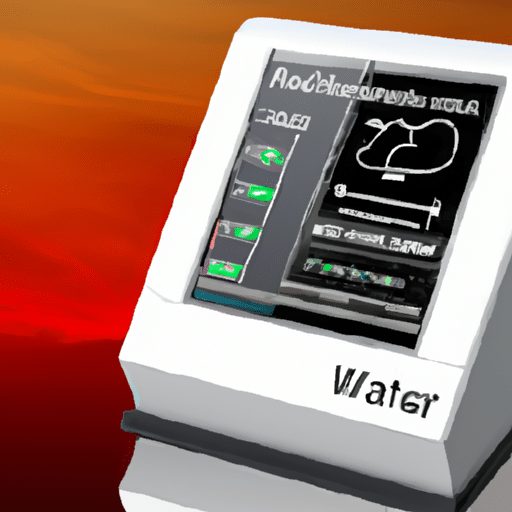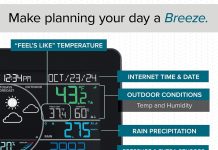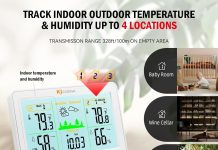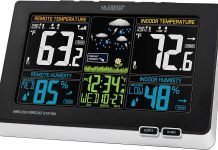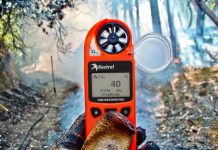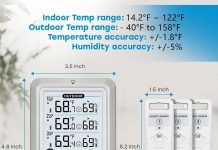Are you considering investing in a home weather station, but wondering if it comes with the burden of a subscription? We are here to put your mind at ease. In this article, we will explore whether home weather stations require a subscription or not, and provide you with all the information you need to make an informed decision. Whether you are a weather enthusiast or simply curious about monitoring the conditions in your backyard, read on to discover the truth about subscriptions and home weather stations.
Review contents
What is a Home Weather Station?
A home weather station is a device that allows individuals to monitor and track weather conditions directly from their own homes. It consists of various components that work together to provide accurate and real-time weather information. With a home weather station, users can easily access valuable data such as temperature, humidity, wind speed, rainfall, and more. This information is useful for a range of purposes, including planning outdoor activities, determining optimal gardening conditions, and staying informed about local weather conditions.
Definition
A home weather station is an instrument or set of instruments that collect and measure various weather-related data in and around a specific location. This data is then displayed on a console or transmitted wirelessly to a connected device, allowing users to easily view and analyze weather conditions. Home weather stations can vary in complexity and features, offering a wide range of options and capabilities.
Components of a Home Weather Station
A typical home weather station consists of several key components that work together to provide accurate and comprehensive weather information. These components include:
-
Outdoor Sensor Array: This includes various sensors such as a thermometer, hygrometer (to measure humidity), anemometer (for wind speed and direction), rain gauge, and barometer (to measure atmospheric pressure).
-
Indoor Console or Display: This is the main control unit that receives data from the outdoor sensors and displays the collected information. It typically features a digital display and may have additional features such as a clock, alarm, and graphing capabilities.
-
Data Transmission: In wireless weather stations, the outdoor sensor array transmits data wirelessly to the indoor console or display. This allows for easy and convenient monitoring without the need for physical connections.
-
Software and Apps: Many home weather stations come with software or smartphone apps that allow users to access and analyze weather data remotely. These platforms provide additional features such as weather forecasts, historical data analysis, and customizable settings.
Types of Home Weather Stations
Home weather stations come in various types, each offering different features and capabilities. The three main types of home weather stations are:
Basic Weather Stations
Basic weather stations are entry-level systems that provide the essential weather measurements such as temperature, humidity, and barometric pressure. These stations typically consist of an outdoor sensor array and an indoor console or display. Basic weather stations are suitable for casual weather enthusiasts or those on a budget who only require basic weather information.
Wireless Weather Stations
Wireless weather stations offer the convenience of wire-free data transmission between the outdoor sensor array and the indoor console or display. This eliminates the need for physical connections and allows the user to place the sensor array in a location best suited for accurate data collection. Wireless weather stations are popular among users who want flexibility in sensor placement and easy access to weather data.
Internet-Connected Weather Stations
Internet-connected weather stations take weather monitoring to the next level by allowing users to access their weather data remotely through the internet. These stations transmit data to online platforms or smartphone apps, providing real-time updates and additional features such as weather forecasts, historical data analysis, and the ability to share data with other weather enthusiasts.
Features of Home Weather Stations
Home weather stations offer a wide range of features to provide users with comprehensive weather monitoring capabilities. Some of the key features include:
Temperature Monitoring
Home weather stations measure ambient temperature and often provide both indoor and outdoor temperature readings. This allows users to track temperature changes throughout the day and accurately gauge the comfort level in different areas of their homes.
Humidity Monitoring
Humidity sensors in weather stations measure the amount of moisture in the air. This information is useful for determining comfort levels, preventing mold and mildew growth, and optimizing conditions for houseplants.
Wind Speed and Direction
Weather stations with anemometers can measure wind speed and direction in real-time. This information is valuable for outdoor activities, gardening, and even monitoring wind conditions for safety reasons.
Rainfall Measurement
Rain gauges in weather stations provide users with precise measurements of rainfall. This is useful for tracking rainfall amounts over time, assessing soil moisture levels, and planning gardening or agricultural activities.
Barometric Pressure
Barometers measure atmospheric pressure, which can provide insights into short-term weather changes. Weather stations with barometers allow users to track pressure trends and predict weather patterns.
UV Index
Some advanced weather stations include UV sensors that measure the intensity of ultraviolet radiation. This information helps users determine the level of sun protection required during outdoor activities or gauge the risk of sunburn.
Indoor Monitoring
In addition to outdoor sensors, some weather stations also include sensors for indoor monitoring. These sensors can measure indoor temperature, humidity, and barometric pressure, allowing users to create a comfortable and healthy indoor environment.
Weather Forecasting
Many home weather stations have built-in weather forecasting capabilities. By analyzing various weather measurements and trends, these stations can provide short-term weather forecasts to help users plan their activities accordingly.
Do Home Weather Stations Require a Subscription?
While some home weather stations require a subscription for accessing premium features or data, there are also subscription-free options available. The choice between subscribing or going for a subscription-free option depends on individual preferences and needs.
Overview of Subscriptions
Subscriptions for home weather stations usually come with additional benefits such as access to premium data, advanced weather insights, and enhanced monitoring options. These subscriptions often involve a recurring fee which can vary depending on the provider and the level of features offered.
Subscription-Free Home Weather Stations
Subscription-free home weather stations provide essential weather data without any additional charges or recurring fees. They often have basic features and offer the core functionality of monitoring temperature, humidity, wind speed, and rainfall. Subscription-free options are ideal for users who prefer a straightforward and budget-friendly weather monitoring solution.
Benefits of Subscription
While subscription-free home weather stations offer basic functionality, opting for a subscription can provide several advantages that enhance the overall weather monitoring experience. Some benefits of subscribing to a home weather station service include:
Access to Premium Data
Subscribing to a weather station service often grants users access to more comprehensive and detailed weather data. This can include historical weather information, extended forecasts, and additional data analysis options. Access to premium data allows users to gain a deeper understanding of weather patterns and make more informed decisions based on this information.
Enhanced Weather Insights
With a subscription, users can enjoy advanced weather insights and analysis tools. This can include features like weather trend analysis, comparison charts, and personalized weather alerts. These enhanced insights provide a more detailed view of weather conditions and help users make better decisions based on the specific weather patterns in their area.
Advanced Monitoring Options
Subscriptions often offer advanced monitoring options that go beyond the basic weather measurements. This can include specialized sensors for monitoring soil moisture, lightning detection, or air quality. These additional monitoring options allow users to gather more specific weather-related data tailored to their individual needs and interests.
Additional Features
Subscribing to a weather station service can unlock additional features and functionality that can greatly enhance the overall user experience. This can include features like integration with smart home systems, compatibility with voice assistants, or the ability to share weather data with other users. These additional features provide added convenience and flexibility in using the home weather station.
Drawbacks of Subscription
While a subscription can provide added benefits, there are also drawbacks to consider before committing to a paid service. Some potential drawbacks of subscribing to a home weather station service include:
Long-Term Costs
Subscriptions often involve a recurring fee that can accumulate over time. Before subscribing, it’s essential to consider the long-term costs associated with the service. Users should evaluate whether the benefits gained from the subscription outweigh the ongoing financial commitment.
Limited Features without Subscription
Some weather stations limit the functionality of their devices without an active subscription. This means that certain advanced features and data analysis options may only be accessible to subscribers. Users who choose not to subscribe may miss out on these additional features, limiting the full potential of the weather station.
Data Privacy Concerns
When subscribing to a weather station service, users may be required to share their weather data with the provider. This raises valid concerns about data privacy and how the collected information is used. It’s important to review the privacy policies and terms of use of the service provider before subscribing.
Choosing the Right Home Weather Station
Choosing the right home weather station involves considering various factors to ensure it meets your specific needs. Some key considerations when selecting a home weather station are:
Consider your needs
Before purchasing a weather station, identify your specific weather monitoring needs. Determine which weather measurements are essential for your purposes, whether it’s simply tracking temperature or requiring advanced features like UV measurement or soil moisture monitoring. Understanding your needs will help you select a station that aligns with your requirements.
Budget
Set a budget for your home weather station purchase. Weather stations vary in price, with more advanced and feature-rich units generally being more expensive. Determine your budget beforehand to narrow down your options and focus on the stations that fall within your desired price range.
Subscription vs. Subscription-Free Options
Decide whether you prefer a subscription-based weather station service that offers additional features or a subscription-free option that provides basic functionality. Consider the benefits and drawbacks outlined earlier to make an informed decision that aligns with your preferences and priorities.
Brand and Quality
Research different weather station brands and consider their reputation and reliability. Read customer reviews and ratings to assess the overall quality and performance of various models. Choosing a reputable brand ensures a higher likelihood of accurate data readings and a durable and long-lasting weather station.
Customer Reviews
Before making a final decision, read customer reviews and testimonials to gather insights from other users. Real-life experiences can provide valuable information about the usability, accuracy, and overall satisfaction with a particular home weather station. Pay attention to any recurring positive or negative feedback that may influence your decision.
Setting Up a Home Weather Station
Properly setting up a home weather station is crucial to ensure accurate and reliable weather data. Consider the following steps when setting up your home weather station:
Location
Choose an appropriate location for your outdoor sensor array. It should be placed away from any obstructions that may affect accurate readings, such as buildings, trees, or other objects that may block wind or sunlight. Place the sensors at a height and position that align with the manufacturer’s guidelines to obtain accurate and reliable data.
Installation
Follow the manufacturer’s instructions for installing the outdoor sensor array and indoor console or display. Ensure that all components are securely mounted and that cables are properly connected. Take the time to familiarize yourself with the control panel and console features to make the most of your weather station.
Connecting to Devices
If your weather station offers wireless connectivity or smartphone app compatibility, follow the instructions to connect it to your desired device. Set up any necessary accounts or applications to ensure seamless data transmission and remote access. Be sure to keep your device and weather station firmware up to date for optimal performance.
Calibration
Calibration is essential to ensure accurate measurements. Many weather stations offer calibration options or recommendations to align the sensors with local weather conditions. Follow the calibration instructions provided by the manufacturer to ensure accurate data readings and reliable weather information.
Maintenance and Troubleshooting
Regular maintenance and troubleshooting can help ensure the smooth operation of your home weather station. Consider the following tasks and common issues:
Regular Maintenance Tasks
- Clean the sensor array periodically to remove any dust, debris, or obstructions that may affect data accuracy.
- Check and replace batteries as needed to ensure consistent power supply for the outdoor sensor array and indoor console.
- Calibrate the sensors periodically to account for any variations or changes in environmental conditions.
- Keep an eye on the data transmission between the sensors and console to ensure proper connectivity and accurate data readings.
Common Issues and Solutions
- Inaccurate temperature or humidity readings could indicate a faulty sensor. Try recalibrating the sensors according to the manufacturer’s instructions or contact customer support for further assistance.
- Connectivity issues may arise between the outdoor sensor array and the indoor console. Ensure that the distance between the two is within the specified range and check for any potential signal interference.
- If the display on the indoor console becomes unresponsive or shows inconsistent data, try resetting the device or contacting customer support for troubleshooting guidance.
Conclusion
A home weather station is a valuable tool for monitoring and tracking weather conditions from the comfort of your own home. Whether you opt for a basic weather station, a wireless model, or an internet-connected system, there are numerous features and options available to suit your specific needs. Depending on your preferences and budget, you may choose to subscribe to a weather station service for access to premium data and enhanced features, or opt for a subscription-free option for basic weather monitoring. With proper setup, regular maintenance, and troubleshooting, your home weather station can provide invaluable weather insights to help you plan your activities, optimize your environment, and stay informed about the ever-changing conditions outside.

